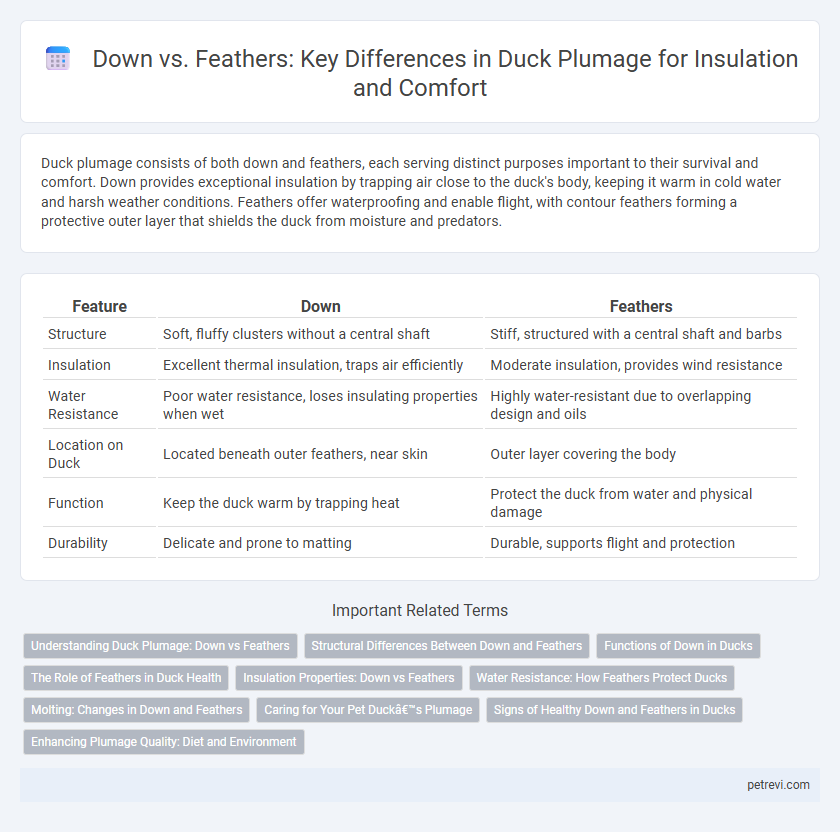Duck plumage consists of both down and feathers, each serving distinct purposes important to their survival and comfort. Down provides exceptional insulation by trapping air close to the duck's body, keeping it warm in cold water and harsh weather conditions. Feathers offer waterproofing and enable flight, with contour feathers forming a protective outer layer that shields the duck from moisture and predators.
Table of Comparison
| Feature | Down | Feathers |
|---|---|---|
| Structure | Soft, fluffy clusters without a central shaft | Stiff, structured with a central shaft and barbs |
| Insulation | Excellent thermal insulation, traps air efficiently | Moderate insulation, provides wind resistance |
| Water Resistance | Poor water resistance, loses insulating properties when wet | Highly water-resistant due to overlapping design and oils |
| Location on Duck | Located beneath outer feathers, near skin | Outer layer covering the body |
| Function | Keep the duck warm by trapping heat | Protect the duck from water and physical damage |
| Durability | Delicate and prone to matting | Durable, supports flight and protection |
Understanding Duck Plumage: Down vs Feathers
Duck plumage consists of two primary types: down and feathers, each serving distinct purposes. Down provides exceptional insulation by trapping air close to the duck's body, ensuring warmth in cold environments, while feathers offer protection from water and aid in flight with their structured, aerodynamic design. Understanding the balance between down and feathers is essential for recognizing how ducks maintain temperature regulation and efficient movement in various habitats.
Structural Differences Between Down and Feathers
Down consists of soft, fluffy clusters of fine filaments with no central shaft, providing superior insulation by trapping air close to the skin. Feathers have a rigid central rachis with interlocking barbs that form a flat, aerodynamic surface essential for flight and waterproofing. The structural difference highlights down's primary function for warmth versus feathers' roles in protection, flight, and display.
Functions of Down in Ducks
Down in ducks serves as a highly efficient insulator, trapping air close to the skin to maintain body heat in cold water and harsh climates. Its soft, fluffy structure provides superior thermal regulation compared to the denser feathers used primarily for waterproofing and protection. This insulation is critical for energy conservation and helps ducks survive in diverse environments.
The Role of Feathers in Duck Health
Duck feathers provide essential waterproofing and insulation, crucial for maintaining body temperature and protecting skin from waterborne pathogens. The outer feathers form a barrier that repels water, while the down feathers trap air, enhancing thermal regulation and buoyancy. Proper feather condition supports overall duck health by preventing hypothermia and reducing susceptibility to infections.
Insulation Properties: Down vs Feathers
Duck down consists of soft, fine clusters with superior loft that traps air efficiently, providing excellent insulation by maintaining warmth without adding weight. Feathers have a more rigid structure with interlocking barbs that offer protection from water and wind but provide less thermal insulation compared to down. The unique composition of down makes it ideal for cold weather insulation, while feathers contribute durability and weather resistance.
Water Resistance: How Feathers Protect Ducks
Duck feathers, especially the outer contour feathers, play a crucial role in water resistance by creating a waterproof barrier that prevents moisture from reaching the skin. Down, found beneath the feathers, provides insulation but lacks water-resistant properties, ensuring ducks remain warm even when wet. The combination of tightly interlocking feathers coated with natural oils enables ducks to repel water efficiently and maintain buoyancy.
Molting: Changes in Down and Feathers
During molting, ducks shed their old feathers and down to make way for new growth, a vital process for maintaining insulation and waterproofing. Down feathers provide exceptional warmth by trapping air close to the body, while contour feathers offer structural support and protection from water. The molting cycle ensures an optimal balance between these feather types, adapting to seasonal temperature fluctuations and aquatic environments.
Caring for Your Pet Duck’s Plumage
Down provides exceptional insulation for your pet duck, trapping heat efficiently to maintain body temperature during cold weather. Feathers create a waterproof barrier essential for swimming and protection, requiring regular gentle cleaning to prevent dirt buildup and ensure optimal function. Regular preening assistance and occasional misting with water help maintain both down and feathers' health, supporting your duck's overall plumage integrity.
Signs of Healthy Down and Feathers in Ducks
Healthy duck plumage is characterized by soft, dense down that provides exceptional insulation and feathers that are smooth and glossy, reflecting a duck's overall vitality. Signs of healthy down include a fluffy, uniform structure without clumps or bald patches, while feathers should lie flat and exhibit a vibrant sheen without fraying or discoloration. Regular preening behavior ensures the removal of dirt and parasites, maintaining the integrity and waterproof quality essential for optimal duck health.
Enhancing Plumage Quality: Diet and Environment
Duck plumage quality significantly improves with a diet rich in omega-3 fatty acids and high-protein sources, which promote optimal down development and feather strength. Providing a clean, stress-free environment with access to clean water supports the natural preening process, ensuring feathers remain waterproof and resilient. Proper nutrition and habitat conditions together enhance both the insulating properties of down and the durability of contour feathers, crucial for maintaining flight efficiency and thermal regulation.
Down vs Feathers for Duck Plumage Infographic

 petrevi.com
petrevi.com